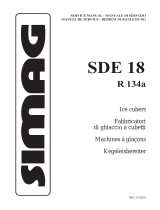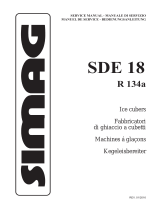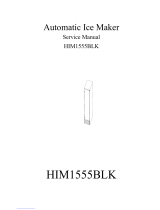Page is loading ...

SERVICE MANUAL
SVD 152/222(22inch Model)
SVD 203/303/503(30inch Model)
Electronic Modular Cubers
Part Number:73000009‐00Version:A

1
TABLE OF CONTENTS
Table of contents 1-2
Specifications 3-11
FOR THE INSTALLER
Introduction 12
Storage bin 12
Standard legs 12
Important operating requirements 12
Select location 12
Storage bin 12
Ice machine 13
Air Baffle 13
Stacking instructions 13
FOR THE PLUMBER
Conform to all applicable codes Water inlet 14
Drains 14
For the electrician
Electrical connections 15
Final check list 16
START-UP
Start-up cycle 17
Freezing cycle 17-18
Harvest cycle 18
OPERATION
Refrigeration during freeze 19
Water system 20
Refrigeration system during harvest 21
Water system 21
Control sequence 21
Alarm conditions 22-23
PC Board set up 24
SERVICE SPECIFICATIONS
Component 25
Operating characteristics 25
COMPONENT DESCRIPTION 26-28

2
WIRING DIAGRAM
SVD 152/222 29
SVD 203/303 30
SVD 503 (220V) 31
SVD 503 (380V) 32
SERVICE DIAGNOSIS 33
MAINTENANCE & CLEANING INSTRUCTION
Icemaker 34
Ice storage bin 34
Cabinet exterior 34
Cleaning (Icemaker) 35

3
SPECIFICATIONS
MODULAR CUBER SVD 152/222
Ice Making Capacity

4
NOTE.To keep your Modular cuber performing at its maximum capacity, it is necessary
to perform periodic maintenance as outlined on page 34&35 of this manual.

5
SPECIFICATIONS
MODULAR CUBER SVD 152/222

6
SPECIFICATIONS
MODULAR CUBER SVD 203
Ice Making Capacity
NOTE. To keep your Modular cuber performing at its maximum capacity, it is necessary to
perform periodic maintenance as outlined on page 31 of this manual.

7
SPECIFICATIONS
MODULAR CUBER SVD 203

8
SPECIFICATIONS
MODULAR CUBER SVD303
Ice Making Capacity
NOTE.To keep your Modular cuber performing at its maximum capacity, it is necessary to
perform periodic maintenance as outlined on page 31 of this manual.

9
SPECIFICATIONS
MODULAR CUBER SVD303

10
SPECIFICATIONS
MODULAR CUBER SVD503
Ice Making Capacity
NOTE.To keep your Modular cuber performing at its maximum capacity, it is necessary to
perform periodic maintenance as outlined on page 31 of this manual.

11
SPECIFICATIONS
MODULAR CUBER SVD503

12
FOR THE INSTALLER
INTRODUCTION
These instructions provide the specifications
and the step-by-step procedures for the
installation, start up and operation for the
SIMAG Model SVD 152-222-203-303-503
Modular Cubers. The Models SVD 152-222-
203-303-503 Modular Cubers are quality
designed, engineering and constructed, and
are thoroughly tested ices making systems,
providing the utmost in flexibility to fit the needs
of a particular user.
STORAGE BIN
SVD 152-222-203-303-503 can stack onto
SIMAG bin model RB 100-150-190-300.
Refrigerant R404A/1R452A
Charge per nameplate rating.
STANDARD LEGS: Furnished with storage
bin. Four legs screw into mounting sockets on
cabinet base. Provide 14-17 cm height
including adjustable leveling foot.
IMPORTANT OPERATING REQUIREMENTS
Air Temperature MINIMUM
10 °C(50°F)
MAXIMUM
40°C (100°F)
Water
Temperature 5°C (40°F) 35°C (90°F)
Water Pressures 1 bar
gauge 5 bar gauge
Electrical Voltage
Variations
Voltage rating
specified on
nameplate
-10% +10%
Extended periods of operation exceeding these
limitations constitute misuse under the terms of
Manufacturer’s Limited Warranty, resulting in a
loss of warranty coverage.
SELECT LOCATION
The first step in installing the equipment is to
select the location. The purchaser of the unit
will have a desired spot in mind, check out that
spot to insure that it is:
- Indoors, in an environment that does not
exceed the air and water temperature
limitations for the equipment.
- That the necessary utilities are available
including the correct voltage electrical power.
- that there be space around the installed
machine for service, 15 cm. minimum left, right,
and rear for air-cooled models.
STORAGE BIN
The Simag bins for these units are the
RB100,RB150, RB190 and RB300.
Other bins may be available with bin tops to
vary the storage capacity. Lay the bin on its
back, using cardboard from the carton to
support it, screw in the legs.
Stand the bin upright, and correct any possible
small tears in the machine mounting gasket
with food grade silicone sealant.
INSTALLATION NOTE: Allow 15 minimum
space at sides and back for ventilation and
utility connections.

13
Page 15
ICE MACHINE
The use of a mechanical lift is recommended
for lifting the uncrated icemaker onto the bin.
Remove front, top and sides panels.
Place the unit directly onto the bin, align it with
the back of the bin. Locate the hardware
package, take out two mounting screws, and
use them to secure the Icemaker to the two
sides of the bin.
See illustration below.
Remove all shipping material as well as the
masking tapes from the ice
Deflector/evaporator cover.
Remove first the ice deflector/evaporator cover
then the masking tape from the ice thickness
sensor.
AIR BAFFLE
Install on the back side of the machine the air
baffle as per instruction provided with it.
STACKING INSTALLATION
To stack a second SVD onto the present one,
first remove the top panel from the lower
machine. Add a bead of food grade silicone
sealant to the top edges of the lower units
freezing compartment. Lift the top machine
onto the bottom machine, (the use of a
mechanical lift is recommended for this step).
Align the two machines cabinets, and using the
2 screw from the top units, hardware package,
fasten the two units together at the side
cabinets.
Then make use of the Stacking Kit KSC 450,
and KSC 1000, to be mounted as per fitting
instructions included in their package,
respectively on SVD 203, SVD303, SVD503
located in the bottom for proper conveying, of
the ice cubes made by the top unit, into the
storage bin.
With food grade silicone perfectly seal the edge
between the freezing compartment of the upper
machine and of the bottom machine so to avoid
any possible leak of water through the
clearance in between.
(Note: SVD152&222 NOT DESIGNED FOR
STACKING.)

14
FOR THE PLUMBER
CONFORM TO ALL APPLICABLE CODES
WATER INLET
AIR-COOLED MODELS: The recommended
water supply is cold water connected to the -
3/4'’ gas - male fitting at the back of the cabinet.
Install a hand valve near the machine to control
the water supply.
1) Plug receptacle
2) Electrical plug
3) Water inlet
4) Shut-off valve
5) Water filter
6) Water inlet line
7) Water outlet line
8) Bin water outlet line
9) Open vented water drain
When choosing the water supply for the SVD
Cuber, consideration should be given to:
A. Length of run.
B. Water clarity and purity.
C. Adequate water supply pressures.
Since water is the most important single
ingredient in producing ice you cannot over
emphasize the three items listed above. Low
water pressure, below 1 bar may cause
malfunction, of the icemaker unit. Water
containing excessive minerals will tend to
produce cloudy colored ice cubes, plus scale
build-up on parts in the water system.
Heavily chlorinated water can be controlled
using charcoal or carbon filters.
DRAINS
AIR-COOLED MODELS: There is one 20 mm.
diameter sump drain fitting at the back of the
cabinet. Insulations in high humidity areas is
recommended. The ideal drain receptacle
would be a trapped and vented floor drain.
STORAGE BIN: A separate gravity type drain
needs to be run, similar to the air-cooled sump
drain. Insulation of this drain line is
recommended.

15
FOR THE ELECTRICIAN
ELECTRICAL CONNECTIONS
The unit comes equipped with an electrical cord
for power supply. The lead wires must be
connected to an electrical plug that
corresponds to the local electrical codes and
requirements or to a separate two poles
disconnect box with opening to the contacts of
about 3 millimeters. The disconnect box should
be placed close to the selected ice maker
location to be easily and prompt reached.
Undersized wiring or improperly installed
electrical circuit will result in major problems
and malfunctions. Voltage variations should not
exceed ten percent.
IMPORTANT - All plumbing and
electrical connections must be made by
licensed plumbers and electricians, this
one must follow the electrical
specifications printed on the ice maker
nameplate.
NOTE:
All SIMAG Cubers require a neutral wire and
a solid earth ground wire to prevent possible
severe Electrical Shock Injury to individuals
or extensive damage to equipments.

16
FINAL CHECK LIST
1.Is the cabinet/bin level?
2. Is the cuber in a location where ambient
temperatures are a minimum of 10℃(50℉) all
year around and to not exceed a maximum of
40℃. (100℉.)
.3. Is there at least a 15 cm. clearance behind
and around the cabinet for all connections and
for proper air circulation?
4. Have all electrical and piping connections
been made?
5. Has the electrical power supply wiring been
properly connected and the voltage tested and
checked against the nameplate rating? Has the
unit properly grounded?
6. Is the water supply line shutoff valve installed
and opened and has the inlet water supply
pressure been checked to insure a minimum
of1 bar without exceeding a maximum of 5 bar.
7. Have the compressor hold down bolts been
checked to be sure the compressor is snug on
the mounting pads.
8.Check all refrigerant lines and conduit lines to
against vibration and possible failure.
9. Has the cuber and the bin been wiped clean
with clean damp cloths?
10. Has the owner/user been given the user
manual and instructed on how to operate the
icemaker and the importance of periodic
maintenance?
11. Has the owner/user been given the name
and telephone number of the authorized
SIMAG distributor or service agency serving
him?
12. Has the manufacturer’s registration card
been properly filled out?
Check for correct Model and serial numbers
from nameplate, and then mail the completed
card to the manufactured.
TYPICAL STACKING INSTALLATION
STACKNG COMBINATIONS:
SVD 203 over SVD 203 (with Kit KSC450)
SVD 203 over SVD 303 (with Kit KSC450)
SVD 303 over SVD 303 (with Kit KSC450)
SVD 203 over SVD 503 (with Kit KSC1000)
SVD 303 over SVD 503 (with Kit KSC1000)
SVD 503 over SVD 503 (with Kit KSC1000)
(SVD 152 & SVD 222 NOT DESIGNED FOR
STACKING)

17
START-UP
START-UP CYCLE
1.Open the water tap/valve and switch ON the
power on the electrical supply line.
2.The models SVD 152-222-
203-303 enter in the Start Up
cycle with the PC Board
energized, and SVD 503 enter
in 90 minutes delay time
controlled by PC Board, The
LED of ICE MAKING blinking
slow.
In Start Up cycle the LED of
ICE MAKING and BIN FULL
are energized, blinking slow3
minutes for water system
clean, then ICE MAKING
blinking fast 40 second for
pressure balance.
3. During the start up cycle the components in
operation are:
• Hot Gas valve
• Water Drain Valve
• Water Inlet Valve
• Water Pump
FREEZING CYCLE
1. After the start up cycle the machine enters
directly into the freezing cycle with the following
components energized:
• Water Inlet valve
• Compressor
• Fan motor.
2. The LED energized are:
• Machine under power (steady)
• Machine in ICE MAKING (steady)
3. Water is coming into the water through the
Water Inlet Solenoid Valve till the water
reservoir if filled up to the maximum level
controlled by a Water Level Sensor.
4. 40 seconds later, the Water Pump starts up.
5. After few minutes (3-5) from the start up of
the freezing cycle, the Water Inlet Solenoid
Valve is activated again for few seconds to refill
the water reservoir up to the maximum level so
to reduce any possibility of slush ice formation.
6.In the meantime the condenser sensor starts
to transmit the current to the PC Board keeping
in operation the Fan Motor in ON-OFF mode or
continuously according to the condenser
temperature.
7. The machine remains in the freezing cycle
with the ice that become thicker till the two
metal plates of the Ice Thickness Sensor are
covered by the water cascading through the
front surface of the ice plate.
8. When the Power is transmitted back to the
PC Board continuously through the metal
plates of the Ice Thickness Sensor for more
than 6", the machine enters in the Pre-Harvest
or directly into the Harvest Cycle mode
according to:
• FAN MOTOR IN ON-OFF MODE DURING
Rise up the cutting temperature of the
condenser sensor to38℃ (fan motor off) and
extend the length of freezing cycle by 30" more
the going to harvest cycle.
• FAN MOTOR ALWAYS IN OPERATION
Go straight to the harvest cycle.
9. First freezing time will range between 15 and
NOTE:
Model SVD503 has a crankcase heater in
the compressor. When the main power to the
machine is switched ON, there is a time
delay of 90 minutes during which only the
compressor heater is energized with Green
ICE Making LED Blinking slowly.
However, if the ambient temperature is
higher than 25*C (77*F), PC Board will
automatically bypass this delay.
This time delay can also be bypass by
pressing the bypass switch located at the
back of the machine.
NOTE: Do not remove the evaporator
deflector cover as it will cause the switching
off of the machine at "STORAGE BIN FULL".

18
20 minutes. Longer time for temperature above
25 ℃ and shorter time required when
temperature are below25℃.Average complete
cycle time is about 22 min.
HARVEST CYCLE
1. During the harvest cycle the components in
operation are:
• Hot Gas valve
• Water Drain/Purge Valve
• Water Pump (According DIP Switch #6)
• Compressor
And both
• Machine under Power
• Machine in Operation
2. After beginning of Harvest Cycle, Purge
Valve will according DIP Switch (#6) setup
to purge water, 20” after the Purge Valve open,
the Water Inlet Solenoid Valve is energized for
10 seconds only in order to have a short flush
of fresh water into the sump while the Water
Pump and Purge valve are still in operation.
3. The Fan Motor remains in OFF mode unless
the Condenser Sensor probe rise up to more
then 38℃ (same set up as per end of freezing
cycle).
4. When the ice plate is falling down from the
evaporator, the magnetic switch is activated for
a while providing the signal to the PC Board to
restart a new freezing cycle.
5. Observe first ice cube harvest and check size
of ice cubes; if an adjustment is required thread
down or out screw NO.1 as shown on below
illustration.
This screw position determines the distance
between the sensor reeds and the egg-crate
evaporator thus keeping the ice cube at a
proper thickness.
6. Observe second and third cube harvest.
Check if size and shape combination is correct.
In areas where extreme problem water
conditions exist, filtering or purifying equipment
is recommended.
7. Check operation of magnetic switch
controlling it by keeping open the bottom end of
plastic deflector for more than 30 seconds. The
machine must switch off at storage bin full.
Release the plastic deflector. The machine
should restart in the freezing cycle mode within
few seconds going through a 3' delay time.
8. Place again all cabinet panels and screws
previously removed.
9. Thoroughly explain to owner/user the
significant specifications of the ice maker
startup, reset and operation, going through the
procedures in the operating instructions.
Answer all questions about the ice maker by the
owner and inform the owner himself of the
name and telephone number of the authorized
service agency serving him.
NOTE: This type of machine produce an "ICE
PLATE" that breaks when falls down into the
storage bin. Setting the ice thickness sensor in
order to have single ice cubes may cause
malfunction of the machine.
NOTE: If water used is too soft, "demineralized"
the ice thickness sensor might not be able to
sense the water on its reeds, thereby it will not
switch the unit on harvest cycle.
A safety system built in the P.C. Board switches
the unit on harvest cycle whenever the freezing
period gets longer than 30’ or 40’.
NOTE: To assure a correct operation of the
machine the water must have a minimum
electric conductivity of 20μs.

19
Page 19
OPERATION
FREEZE CYCLE
REFRIGERATION SYSTEM SCHEMATIC
REFRIGERATION DURING FREEZE:
This ice machine employs either air or water as
a condensing media, the refrigeration system
for either one is a follows:
At the hermetic compressor, Refrigerant is
compressed into a high temperature, high
pressure gas.
The gas moves through the discharge line into
the condenser, air or water-cooled. If air-
cooled, the discharge pressure will change with
the heat load and the ambient air temperature.
If water-cooled, the discharge pressure is
controlled by the amount of water flowing
through the condenser - which is determined by
the water regulating valve.
After the gas is cooled in the condenser, giving
up much of its heat, the gas condenses into a
high pressure liquid. This liquid travels through
the liquid line to the metering device, a
thermostatic expansion valve.
The thermostatic expansion valve meters how
much liquid refrigerant is to be allowed into the
evaporator section of the refrigeration system.
This is determined by the temperature of the
TXV sensing bulb, located on the suction line
manifold, at the outlet of the evaporator.
If the bulb senses a warm suction line, more
refrigerant is allowed into the evaporator,
(common at the beginning of the freeze cycle)
and when the temperature begins to fall, less
refrigerant is allowed through.
This is why the suction side gauge pressure will
decline throughout the freeze cycle. At the
evaporator, the liquid refrigerant released from
high pressure, boils off in the low pressure
environment and absorbs heat, thus cooling the
evaporator surface and anything near it, such
as water.
The low pressure refrigerant vapor then is
forced through the heat exchanger where any
excess liquid refrigerant boils-off, allowing only
refrigerant vapor to enter the compressor
suction tube, where it is recompressed into high
pressure, high temperature gas again and the
cycle repeats.
/








